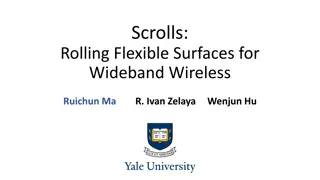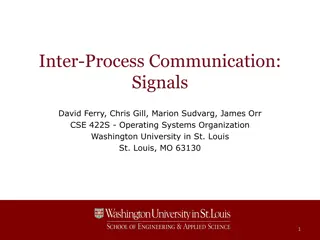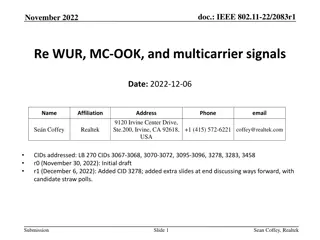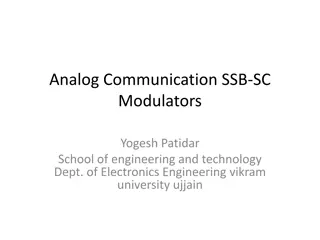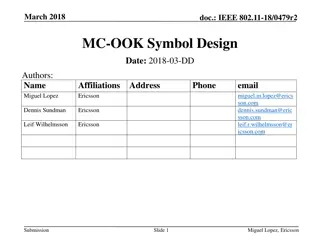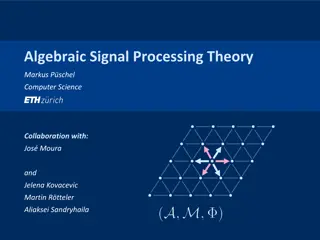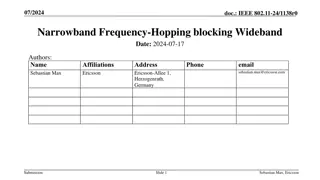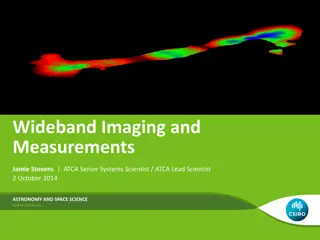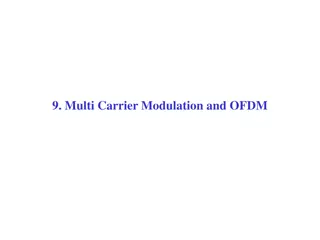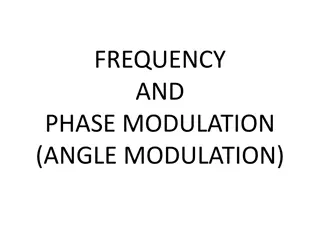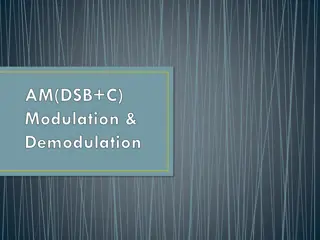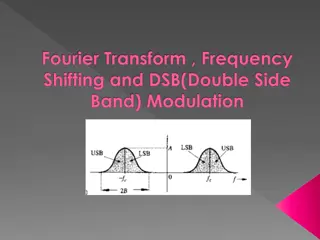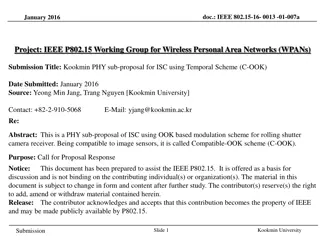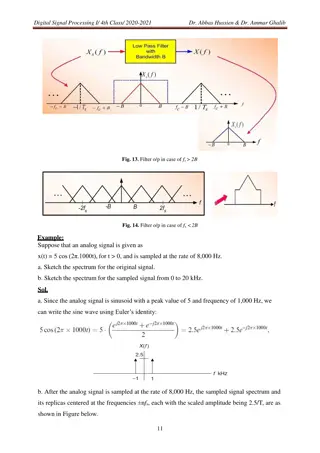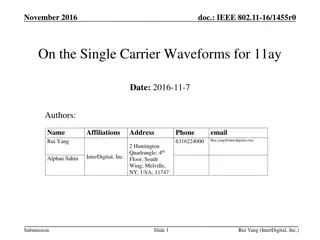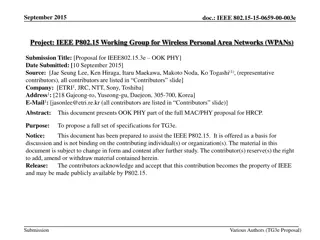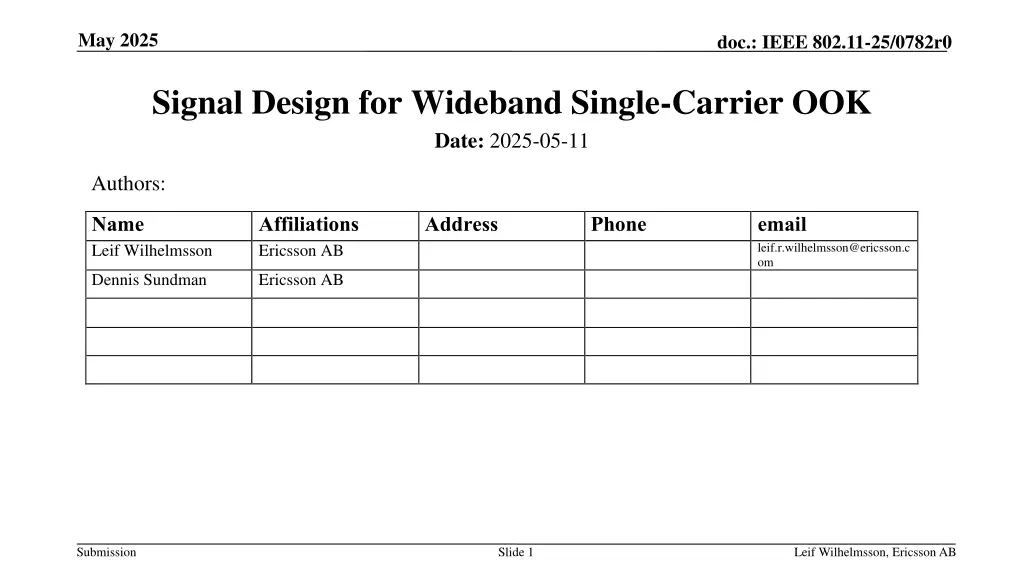
Efficient Signal Design for Wideband Single-Carrier OOK Communication
Explore the optimization of signals for wideband single-carrier OOK systems, focusing on achieving high transmission power and low peak-to-average power ratio (PAPR). Consider different approaches and signal properties to enhance communication efficiency.
Uploaded on | 1 Views
Download Presentation

Please find below an Image/Link to download the presentation.
The content on the website is provided AS IS for your information and personal use only. It may not be sold, licensed, or shared on other websites without obtaining consent from the author. If you encounter any issues during the download, it is possible that the publisher has removed the file from their server.
You are allowed to download the files provided on this website for personal or commercial use, subject to the condition that they are used lawfully. All files are the property of their respective owners.
The content on the website is provided AS IS for your information and personal use only. It may not be sold, licensed, or shared on other websites without obtaining consent from the author.
E N D
Presentation Transcript
May 2025 doc.: IEEE 802.11-25/0782r0 Signal Design for Wideband Single-Carrier OOK Date: 2025-05-11 Authors: Name Leif Wilhelmsson Affiliations Ericsson AB Address Phone email leif.r.wilhelmsson@ericsson.c om Dennis Sundman Ericsson AB Submission Slide 1 Leif Wilhelmsson, Ericsson AB
May 2025 doc.: IEEE 802.11-25/0782r0 Abstract It has been agreed that the (3dB) bandwidth of the AMP DL PPDU in 2.4 GHz is at least 10 MHz for backscattering communication. The transmit spectrum mask is TBD. Two different approaches for achieving a large bandwidth for low data rates OOK were described in [1] and [2]. In [1], the design was using multi-carrier transmission. In [2], it was proposed to use single carrier. In this contribution, a similar approach as was taken in [1] is used to find a good signal design based on single carrier transmission. Submission Slide 2 Leif Wilhelmsson, Ericsson AB
May 2025 doc.: IEEE 802.11-25/0782r0 Outline Recap of desired signal properties Some illustrations Methods for obtaining the desired signal properties Some examples obtained by numerical search Conclusions Submission Slide 3 Leif Wilhelmsson, Ericsson AB
May 2025 doc.: IEEE 802.11-25/0782r0 Recap of desired signal properties - Frequency Wideband signals are desirable to benefit from frequency diversity and to allow for high TX power in PSD limited regions We use the term maximum allowable power (MAP) to refer to the maximum transmission power allowed under a PSD limit of 10 dBm/MHz A signal that achieves higher MAP will also allows for better frequency diversity When comparing two signal alternatives, the one that allows for larger MAP is considered the better one Submission Slide 4 Leif Wilhelmsson, Ericsson AB
May 2025 doc.: IEEE 802.11-25/0782r0 Recap of desired signal properties - Time The signal should have as low PAPR as possible When comparing two signal alternatives, the one with the smallest PAPR is considered the better one Note: To measure PAPR, we must consider the signal after the LPF needed to fulfill the TX spectrum mask Submission Slide 5 Leif Wilhelmsson, Ericsson AB
May 2025 doc.: IEEE 802.11-25/0782r0 Some illustrations Suppose the OOK data rate is 250 kb/s and a random spreading sequence (+-1) of 11chips/s is used to increase the bandwidth The spreading sequence has good PAPR However, since the generated signal after spreading does not fulfil the TX mask it needs to be filtered by a suitable LPF The signal after the LPF may be very far from constant envelope On the following page some illustrations are provided to illustrate the problem Submission Slide 6 Leif Wilhelmsson, Ericsson AB
May 2025 doc.: IEEE 802.11-25/0782r0 Some illustrations PAPR 9.7 (6.7) dB PAPR 8.45 (5.45) dB PAPR 3 (0) dB Submission Slide 7 Leif Wilhelmsson, Ericsson AB
May 2025 doc.: IEEE 802.11-25/0782r0 Methods for obtaining the desired signal properties Try to generate/find a binary spreading sequence that is reasonbly flat in the passband (to achieve high MAP) that falls off reasonably fast outside of the passband, so that not too much filtering is needed to fulfill the spectrum mask as filtering impacts the PAPR Reasonably good spectrum here means 3dB BW > 10 MHz as this is a requirement Preferably as flat as possible within the 22 MHz channel, to be described later No large sideloobs outside of the 22 MHz channel Submission Slide 8 Leif Wilhelmsson, Ericsson AB
May 2025 doc.: IEEE 802.11-25/0782r0 Method for obtaining the desired signal properties 1. A random spreading sequence at 11 Mchips/s is generated 2. This signal is the ON part in the Manchester coded OOK symbol 3. The Manchester coded OOK signal is filtered by a LPF to fulfill the TX spectrum The simulations are done a 4x oversampling to study the spectrum outside of the 22 MHz channel Submission Slide 9 Leif Wilhelmsson, Ericsson AB
May 2025 doc.: IEEE 802.11-25/0782r0 Search for a suitable ON signal The selected signal should have the following properties (TX mask assumed met) The TX power shoud have as high MAP as possible The PAPR should be as small as possible In the search, the following Frequency-time metric is used FT_metric = MAP (dBm) PAPR (dB) A sequence is considered better if the FT_metric is higher Note: If a sequence with a good FT_metric is found, but the TX mask is not met (with sufficient margin), this may be easily fixed by (i.e., no need for new search) Slightly decreasing the BW of the LPF assumed present to meet the TX spectrum mask Submission Slide 10 Leif Wilhelmsson, Ericsson AB
May 2025 doc.: IEEE 802.11-25/0782r0 Performance 250kb/s The best ON-signal according to the ad-hoc metric is shown to the right Sequence = [-1 1 -1 1 -1 1 -1 -1 -1 -1 1 -1 -1 1 1 -1 1 -1 -1 1 1 1] The MAP is 20.6 dBm and the PAPR is 5.7 dB for the entire signal part (around 3 dB less for ON part) Note: The sequence is randomized for different symbols by adding a random phase (0,2pi] Submission Slide 11 Leif Wilhelmsson, Ericsson AB
May 2025 doc.: IEEE 802.11-25/0782r0 Performance 1Mb/s The best ON-signal according to the ad-hoc metric is shown to the right Sequence = [-1 -1 1 -1 1] The MAP is 19.04 dBm and the PAPR is 5.7 dB for the entire signal part (around 3 dB less for ON part) Note: The ON part is 5 chips and the OFF part is 6 chips. Due to the LPF, the ON part becomes slightly longer Submission Slide 12 Leif Wilhelmsson, Ericsson AB
May 2025 doc.: IEEE 802.11-25/0782r0 Conclusions It is possible to design a single-carrier OOK signal which has both good frequency and time properties for both 250 kb/s and 1 Mb/s using a single- carrier approach Compared to the design reported in [1], the found signal has (slightly) worse properties if the Maximum Allowed Power and PAPR are considered Somewhat surprising, the PAPR is superior when the design is based on a multi-carrier signal Submission Slide 13 Leif Wilhelmsson, Ericsson AB
May 2025 doc.: IEEE 802.11-25/0782r0 References 1. L. Wilhelmsson et al., Signal Design for Wideband Multi-Carrier OOK , IEEE 802.11-25/0369r1. 2. P. Li et al., DL Wideband OOK Generation , IEEE 802.11-25/0050r1. Submission Slide 14 Leif Wilhelmsson, Ericsson AB

